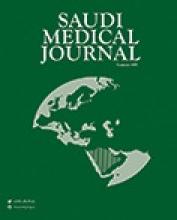Abstract
OBJECTIVE: To study lipoprotein(a) [Lp(a)] levels in Saudi patients with angiographically defined coronary artery disease and to see its relationship with its severity and diffuseness.
METHODS: This cross sectional study was carried out at King Khalid University Hospital, Riyadh, Saudi Arabia in 2006-2007. One hundred and forty-seven individuals with coronary artery disease (CAD) and 49 healthy individuals matched for age and body mass index were studied. Among CAD patients, 133 underwent angiography. Blood samples were analyzed for total cholesterol (TC), triglycerides (TG), low density lipoprotein (LDL) and high density lipoprotein (HDL) and Lp(a).
RESULTS: Coronary artery disease patients had higher Lp(a) levels than controls (25.78 ± 25.09mg/dl versus 14.57 ± 11.81 mg/dl, p=0.0030). Patients without stenosis (10.97 ± 8.06mg/dl) and one vessel involvement (19.67 ± 17.33mg/dl) had significantly lower levels of Lp(a) compared to double (31.88 ± 32.17mg/dl) and triple (29.70 ± 28.12mg/dl) vessel disease. Lipoprotein(a) levels correlated significantly with coronary vessel score (r=0.234, p=0.033) and Gensini score (r=0.256, p=0.02). Smoking (odds ratio [OR]: 1.86; 95% confidence interval [CI]: 1.020-2.510; p=0.04), TG levels (OR: 2.04; 95% CI: 1.251-4.932; p=0.03) and Lp(a) levels (OR: 1.56; 95% CI: 1.033-3.687; p=0.025) significantly predicted CAD severity. High risk levels of Lp(a) >/=30 mg/dL were present in 66.7% of CAD patients.
CONCLUSION: Lipoprotein(a) levels are significantly higher in Saudi patients with CAD compared to healthy individuals, and are associated with more severe and diffuse blockage of the coronary vessels.
- Copyright: © Saudi Medical Journal
This is an open-access article distributed under the terms of the Creative Commons Attribution-Noncommercial-Share Alike 3.0 Unported, which permits unrestricted use, distribution, and reproduction in any medium, provided the original work is properly cited.






